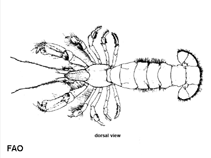| Upogebiidae (mud shrimps) |
| 15 cm TL (male/unsexed); 10.5 cm TL (female) |
|
benthic; brackish; marine; depth range 0 - 1 m |
| Eastern Pacific: Prince William Sound, Alaska to Morro Bay, California, USA. |
|
Rostrum ending in three teeth, the median tooth broad and triangular, the lateral teeth much shorter. A groove between the median and lateral teeth, also a very shallow median longitudinal groove. Lower surface of rostrum without spines. Anterolateral border of carapace with a very small tooth at the level of the eye. First pereiopods subchelate. Dactylus of adult male on inner surface with a longitudinal row of 6-12 tubercles, that are placed close together. Carpus with some anterior spines. Merus with a subdistal anterodorsal spine (Ref. 4). |
| It has lengths of 11 cm, total body length (Ref. 259); 15 cm (males) and 10.5 cm (females), total length (Refs. 4, 258). It burrows in muddy sand of the intertidal zone, sometimes under rocks; burrows are Y-shaped, and about 0.6 to 1 m deep (Ref. 4). Found in bays and estuaries (Ref. 112892). |
|
Not Evaluated (N.E.) Ref. 123251)
|
|
|
Source and more info: www.sealifebase.org. For personal, classroom, and other internal use only. Not for publication.

